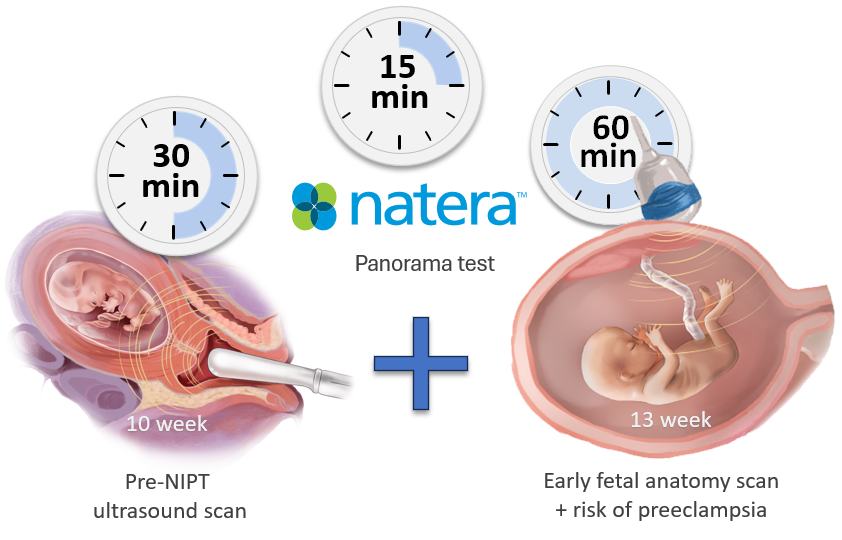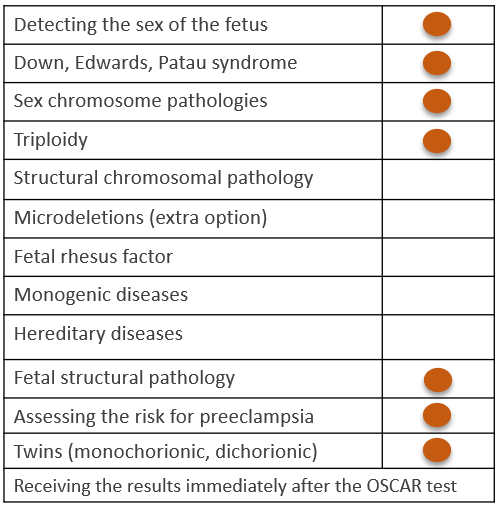Panorama test + OSCAR test
This is a combined first trimester screening that takes advantage of the strengths of both the OSCAR test and the Panorama test, giving a new, significantly more accurate and comprehensive screening test than the aforementioned tests in their own right.
We recommend that all pregnant women combine the Panorama test with the OSCAR test.
Preferably, we recommend this modern combined screening for women who are expecting twins.
- In multiple pregnancies, congenital developmental defects and chromosomal disorders of the fetus are more common. The Panorama test can be performed at a very early stage of pregnancy, and the OSCAR test can be used to assess 100 different types of severe fetal birth defects. This gives the possibility to carry out selective fetal reduction in the case of one twin's unsuitable developmental defect at an early stage of pregnancy, increasing the chances of the unaffected twin being born alive and healthy.
- Monozygous twins sharing a single placenta are at increased risk for life-threatening twin-to-twin transfusion syndrome. The Panorama test can distinguish monozygotic twins from dizygous twins. During the ultrasound examination of the OSCAR test, it is possible to assess the risk of developing a transfusion syndrome between monozygous twins and, based on this, plan future pregnancy monitoring. In the early detection of twin-to-twin transfusion syndrome, it is possible to save the lives of the twins by performing a fetoscopic laser surgery at the right time.
Preferably, we recommend this modern combined screening for overweight women.
- Overweight women have a lower concentration of fetal extracellular DNA in a blood test. Since the Panorama test is able to reliably assess the fetal extracellular DNA already at a very low concentration in the mother's venous blood, in this test there is a lower chance that the laboratory will not be able to perform analysis due to the low amount of fetal DNA and thus the test will fail. In the case of the Panorama test, there is also less chance of obtaining false negative results, where the test shows that the child is healthy, but the child is still diagnosed with the disease at birth. Due to thick abdominal covers, there is a very high risk that the organs of the fetus are not well assessed with the abdominal ultrasound transducer during the ultrasound examination of developmental defects in the fetus at the 20th week of pregnancy, and therefore there is a significantly increased risk that dangerous developmental defects will remain undiagnosed in the prenatal period. The ultrasound examination of the OSCAR test can be performed using a vaginal ultrasound transducer, which makes the fetal organs more evaluable and mistakes less likely to occur.
Performing combined screening.
- For the Panorama test, only the mother's venous blood analysis is required.
- To perform the combined test, the patient gives a blood test for the Panorama test at the 10th week of pregnancy and comes to the ultrasound examination of the OSCAR test at the 13th week of pregnancy. If you would like to know the duration of your pregnancy, please visit our pregnancy calendar.
- If desired, the Panorama test makes it possible to know the sex of both fetuses very reliably.
- The answer to the combined screening test can be found immediately after performing the OSCAR test ultrasound examination.
As an additional service, you may want to combine the Panorama test with microdeletions.
- When combined with the detection of DiGeorge syndrome, the Panorama test can be used for single pregnancies and twin pregnancy with one placenta.
- If the Panorama test is combined with five different microdeletions (DiGeorge syndrome, 1p36 deletion syndrome, Angelman, cri-du-chat and Prader-Willi syndromes), this test can only be used for single pregnancies.
The price of the test include a very early ultrasound examination of fetal developmental defects.
Very early fetal developmental ultrasound with the NIPT tests is the most accurate combined prenatal screening method for the early detection of children with chromosomal diseases. The purpose of an ultrasound scan is to first determine the size of the pregnancy, to assess the presence and type of a possible multiple pregnancy, and then to exclude situations in which the NIPT test should not be performed. Since the NIPT test cannot detect structural developmental defects in a child, the objective of the ultrasound examination of very early developmental defects in the fetus is to exclude 10 severe developmental defects in the child.


